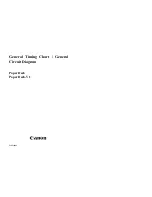
Table 3-105
3. OPERATIONS AND TIMING
COPYRIGHT © 1996 CANON INC.
CANON NP6085 REV.0 JULY 1996 PRINTED IN JAPAN (IMPRIME AU JAPON)
3-29
Purpose
The scanning lamp illumi-
nates the original on the
left of the copyboard, and
the reflected optical image
is projected on the photo-
sensitive drum through
mirrors and lenses.
•
.
The scanner is returned
to the home position in
preparation for the next
copy.
•
.
The toner image on the
drum is transferred to
the copy paper.
The scanner lamp illumi-
nates the original on the
right, and the reflected
optical image is projected
on the photosensitive
drum through mirrors and
lenses.
•
.
The scanner is returned
to the home position for
the next copy.
•
.
The toner image on the
drum is transferred to
the copy paper.
While the scanner is
moving forward.
•
.
The distance over which
the scanner moves for-
ward varies according
to the copy paper size
and the selected repro-
duction ratio.
From when the scanner
starts to move in reverse
until the copy paper is dis-
charged.
While the scanner is
moving forward.
•
.
The distance over which
the scanner is moving
forward varies accor-
ding to the copy paper
size and the selected
reproduction ratio.
From when the scanner
starts to move in reverse
until the developing clutch
turns OFF.
SCFW1
(scanner forward
1; copying origi-
nal on left)
SCRV1
(scanner reverse 1)
SCFW2
(scanner front 2;
copying original
on right)
SCRV2
(scanner reverse 2)
Remarks
•
.
The registration signal is
generated, and the
copy paper is moved to
the transfer assembly.
•
.
The pick-up signal is
generated, and the next
copy paper is picked up.
The registration signal is
generated so that the ima-
ge leading edge of the ori-
ginal on the right matches
the copy paper in referen-
ce to the SCDP signal.
Period
















































